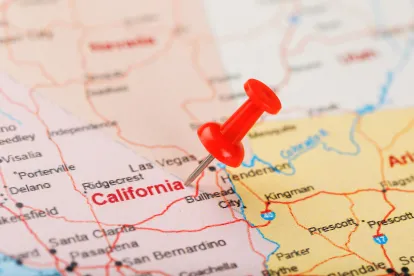On November 19, 2020, California’s Division of Occupational Safety and Health (Cal/OSHA) adopted emergency temporary standards on Coronavirus (COVID-19) prevention in the workforce, effective November 30, 2020, if approved as expected by the Office of Administrative Law. These temporary standards will require most California employers to implement a written COVID-19 prevention program meeting certain criteria, comply with training and testing requirements, and provide paid leave to those with work-related Covid-19 exposure. While many employers have already followed guidance issued by Cal/OSHA to minimize employees’ exposure to COVID-19, Cal/OSHA’s new requirements warrant immediate review of current policies to ensure compliance.
In Depth
On November 19, 2020, California’s Division of Occupational Safety and Health (Cal/OSHA) adopted emergency temporary standards on Coronavirus (COVID-19) prevention in the workforce, effective November 30, 2020, if approved as expected by the Office of Administrative Law. These temporary standards will require most California employers to implement a written COVID-19 prevention program meeting certain criteria. While many employers have already followed guidance issued by Cal/OSHA to minimize employees’ exposure to COVID-19, Cal/OSHA’s new requirements warrant immediate review of current policies to ensure compliance. For any companies that have not yet created a written plan, the rules require implementation of a written policy.
Who is covered?
The new standards are applicable to all California employers, except for:
- Employees who work from home
- Places of employment with only one employee if the employee has no contact with others
- Employers covered by Cal/OSHA’s Aerosol Transmissible Diseases Standard, which applies to work at certain healthcare facilities, laboratories and a limited number of other employers
Healthcare employers excluded from this new standard include:
- Hospitals
- Skilled nursing facilities
- Clinics, medical offices and other outpatient medical facilities
- Facilities where high hazard procedures are performed
- Home healthcare
- Long-term healthcare facilities and hospices
- Medical outreach services
- Paramedic and emergency medical services, including when provided by firefighters and other emergency responders
- Medical transport.
What is required?
The central requirement of the new emergency standards is that employers must prepare, implement and maintain a written COVID-19 prevention program. The prevention program must provide for the following:
- Establishing a system for communicating information to employees about COVID-19 prevention procedures, testing, symptoms and illnesses, including a system for employees to report exposures without fear of retaliation
- Identifying and evaluating hazards, including screening employees for symptoms and identifying workplace conditions and practices that could result in potential exposure
- Investigating and responding to cases in the workplace, including responding immediately to potential exposures by following steps to determine who may have been exposed, providing notice within one business day about potential exposures, and offering testing to workers who may have been exposed
- Correcting COVID-19 hazards, including correcting unsafe conditions and work practices and providing effective training and instruction
- Physical distancing, including implementing procedures to ensure workers stay at least six feet apart from other people if possible
- Providing face coverings and ensuring they are worn
- Adopting site-specific strategies such as changes to the workplace and work schedules and providing personal protective equipment to reduce exposure to the virus
- Meeting requirements for positive COVID-19 case and illness recording and making the COVID-19 prevention plan accessible to employees and employee representatives
- Removing COVID-19 exposed workers and COVID-19 positive workers from the workplace with measures to protect pay and benefits
- Establishing criteria for employees to return to work after recovering from COVID-19
- Meeting requirements for testing and notifying public health departments of workplace outbreaks (three or more cases in a workplace in a 14-day period) and major outbreaks (20 or more cases within a 30-day period)
- Meeting specific requirements for infection prevention in employer-provided housing and transportation to and from work.
Will employers that already have COVID-19 safety policies need to make any adjustments to existing policies?
While many employers have already implemented protocols that are contemplated by the new emergency standards, the emergency rules impose specific and nuanced obligations on employers in the event of COVID-19 exposure or an outbreak in the workplace that existing workplace safety plans are unlikely to include. For example:
- Employers must offer COVID-19 testing at no cost, during working hours, to all employees who had a potential COVID-19 exposure in the workplace.
- Employers must exclude from the workplace any employees with COVID-19 cases and those who were exposed to COVID-19 until they satisfy certain return-to-work criteria.
- Employers must exclude an employee from the workplace if:
- The employee receives a positive COVID-19 test.
- The employee is exposed to COVID-19, in which case the employee must be excluded for 14 days after the last known COVID-19 exposure.
- An employee who is symptomatic and tests positive for COVID-19 may not return to work until that employee meets all of the following requirements:
- The employee has not had a fever of 100.4 degrees or higher for at least 24 hours, and that fever resolved without the use of fever-reducing mediations;
- COVID-19 symptoms have improved.
- At least 10 days have passed since COVID-19 symptoms first appeared.
- An employee who is not symptomatic but tests positive for COVID-19 may not return to work until a minimum of 10 days have passed since the date of the COVID-19 test.
- While an employee is excluded from the workplace, the employer must continue and maintain the excluded employee’s earnings, seniority and benefits.
- Paid leave must be provided while the employee is excluded from the workplace unless (1) the employee is unable to work for reasons other than protecting persons at the workplace from COVID-19 transmission, or (2) the employer can demonstrate that the exposure was not work-related. Additionally, there is no limit on the “leave” in the requirement, meaning that an employee could receive it multiple times. The pay requirement can be satisfied by an employer’s existing paid leave policies and other public sources where permitted by law and not covered by workers’ compensation.
- Employers cannot require a negative COVID-19 test for an employee to return to work. This is a departure from prior general federal guidance issued by the Equal Employment Opportunity Commission regarding the permissibility of COVID-19 viral tests under the Americans with Disabilities Act.
- If there is an outbreak (defined as when a local health department identifies a workplace as an outbreak location, or when there are three or more COVID-19 cases in an exposed workplace during a 14-day period), an employer must:
- Provide testing immediately to all employees in the exposed workplace during the outbreak period and additional testing one week later
- After the first two COVID-19 tests, provide COVID-19 testing of employees who remain at the workplace, at least once per week or more frequently if required by a local health department
- Exclude from the workplace all employees who have tested positive with COVID-19 and employees with a COVID-19 exposure
- Immediately investigate and determine the possible workplace factors that contributed to the outbreak and take appropriate corrective action
- Document the investigation in the manner set forth in detail by the emergency standardsNotify the local health department immediately, and no longer than 48 hours after knowledge of the outbreak, and include detailed information about the scope of the outbreak.
- Employers must take additional measures if there is a “Major COVID-19″ Outbreak”, which is defined as an outbreak of 20 or more COVID-19 cases within a 30-day period, until there are no new cases for a 14-day period. These additional measures require an employer to:
- Conduct twice-weekly free testing during employees’ work hours
- Evaluate and possibly correct the employer’s ventilation system
- Determine the need for a respiratory protection program or make changes to it
- Evaluate whether to halt some or all operations until the COVID-19 hazards have been corrected.
While this list is not exhaustive of the new requirements under the emergency standards, it is clear that even California employers with robust written COVID-19 safety policies will likely be required to amend existing policies to achieve compliance.
Finally, the new emergency standards place additional burdens on employers that provide employee housing and/or motor vehicle transportation to and from work. Employers that provide these services for employees should carefully review the requirements to determine what additional measures must be taken to comply with the new standards.
How long will these new emergency standards remain in place?
Once approved and published, the emergency standards will remain in effect for 180 days unless renewed, withdrawn or replaced.
What about interaction with other state and local laws?
Clearly, these new requirements are substantial and raise many questions, specifically as to how they relate to other county, state and federal rules and regulations. Cal/OSHA plans to publish FAQs in the near future. However, given the exceedingly short timeframe for compliance, employers should immediately begin to review and update their COVID-19 protocols and procedures to ensure compliance with this emergency rule.




 />i
/>i

